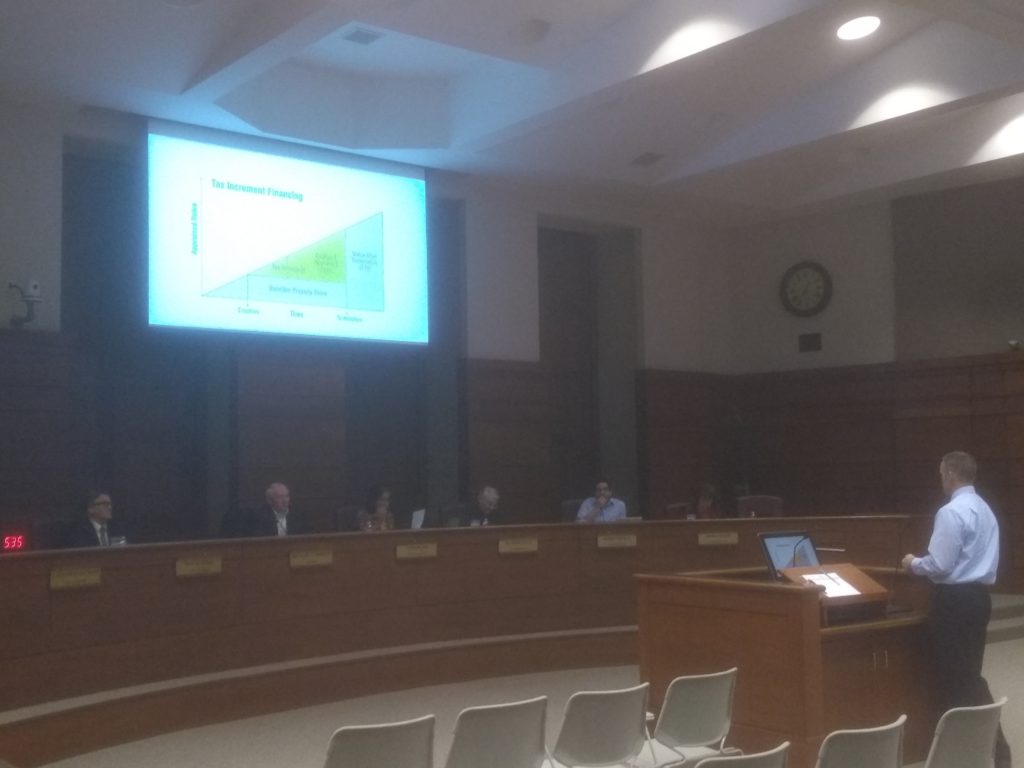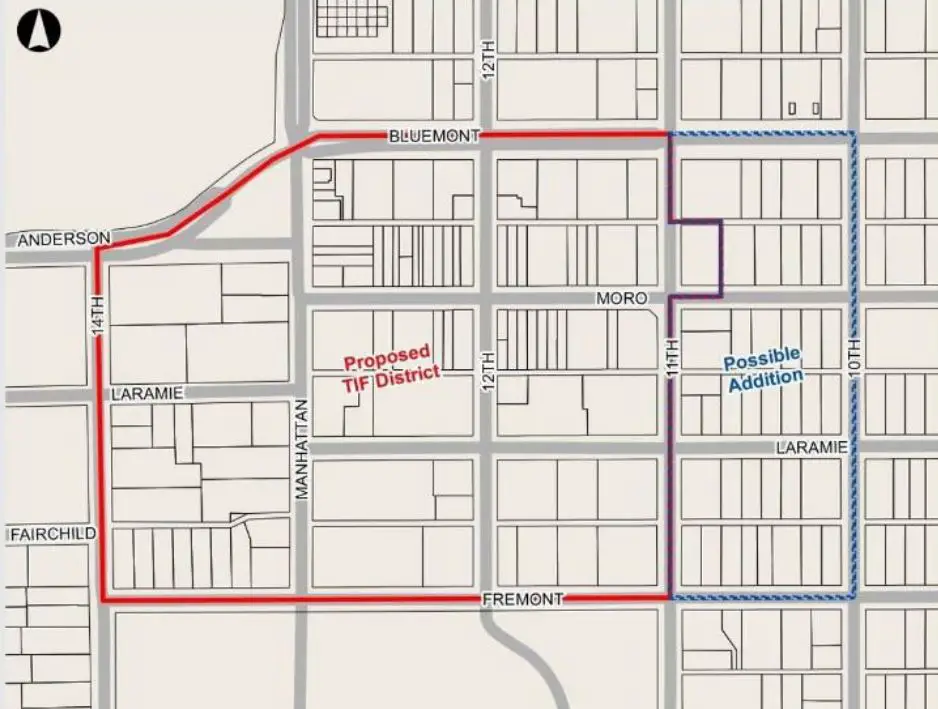
Deputy City Manager Jason Hilgers presents on a proposed Aggieville TIF district at a Manhattan City Commission work session, Jan. 16, 2019. (Nick McNamara/KMAN)
Manhattan Commissioners were unanimously supportive of a proposed tax increment finance — or TIF — district in Aggieville after a discussion during their Tuesday work session.
Establishing a TIF district would allow the city to capture growth in property valuation — and subsequently, property taxes — over a 20 year period within a set boundary for public redevelopment purposes. The city would use the money captured by the district — estimated between $9.6 million and $11.6 million — for public improvements around Aggieville. The total costs of possible improvements around Aggieville are estimated to run between $23.3 million and $30 million, with the parking garage alone expected to cost between $9.5 million and $12.6 million.
The city has employed TIF districts in the past, namely around the Manhattan Town Center and in the Downtown area. According to Deputy City Manager Jason Hilgers, the Downtown TIF district has grown “significantly” — generating $1.6 million per year.
The commission looked at two potential boundaries for the district. One encased the typical area of Aggieville, from Bluemont to Fremont and from 11th to 14th. Manhattan’s financial advisor, Springsted Incorporated, projected the net proceeds of the district with those boundaries would be between $9.6 million and $10.7 million. The other proposed boundary would expand the district eastward to 10th street, which Springsted estimated would set the net proceeds between $10 million and $11.6 million.

Proposed Aggieville TIF district boundaries. (courtesy of the City of Manhattan)
Hilgers says there is opportunity in extending the district to 10th street as there are many single-family rental properties in those blocks. As Aggieville continues to grow, he says there’s potential for further development of more high density housing which will add to the valuation — and thus revenue — increase.
“If they’re included in the TIF, it gives the TIF more revenue,” Hilgers says. “And it also gives the Aggieville “red” district [the typical Aggieville boundary]an opportunity to point towards an area, both to the east and to the north, where zoning is set up for high density housing.”
All commissioners were in favor of the extended district, including Mayor Mike Dodson.
“We’ve got a lot of heavy lifting to do in front of us,” says Dodson. “And once we get some more specific pricing on what those things look like, we’ll have a better idea of how to make a decision on what goes first, what goes second.”
Aggieville Business Association Interim Executive Director Ryan Bramhall was also in favor of the proposal. Bramhall spoke during public comment saying that tenants and property owners throughout Aggieville are “95 percent” in favor of the TIF district as well as a parking garage that’s in the Aggieville plan.
“That is huge for us down there,” Bramhall says. “I know some people don’t think there’s a huge parking issue down there, but when you;’re down there seven days a week you see it. Right now a lot of people are gone so it’s not [impacted], but once we get into the warmer months we’re going to see more and more of this issue pop up.”
Multiple commissioners expressed concern about prioritizing the parking garage over other planned improvements around the district, including Commissioner Jerred McKee. McKee raised concerns about putting that project first after seeing that the revenue projected from the TIF would only pay for one third of all planned projects in Aggieville.
“I have real hesitation in putting the entire TIF money into that parking garage first,” says McKee. “I don’t know even what evidence I’m looking for, but right now we’re putting a lot of weight on the fact that a parking garage is going to spur additional investment.”
McKee says he’d like to see more research into how parking garages impact investor behavior. He also expressed concern about whether future commissions will be able to raise an additional $20 million for the other projects.
Mayor Pro Tempore Usha Reddi agreed with McKee’s sentiments, and says he thinks the garage should funded in part by possible parking fees in that garage.
“I don’t want 100 percent of the garage to be financed by just the TIF money collected,” Reddi says. “If there’s also going to be fees of $2 or $5 or $25, whatever it is, that also has to be part of that equation.”
Commissioner Wynn Butler was of the mind to let the decision over the garage be in the hands of property owners in Aggieville.
Commissioner Linda Morse expressed that she’s not a huge fan of the garage, but also that she doesn’t want Aggieville’s changes to have any impact on City Park.
As commissioners were agreeable with the district, the next step is to pass a resolution establishing a public hearing on the TIF district. Following the public hearing, the commission would vote on a first reading of an ordinance creating the TIF district, at which point Manhattan-Ogden USD 383 and Riley County will both have a 30 day window to review the ordinance and veto the district if they feel it will impact them negatively. If they have no objections, the ordinance will return to the commission for a second reading and final approval which sets the boundaries of the district and sets the base line of valuation and any increases in valuation will be captured.
Then the commissioners will have to consider one or more redevelopment plans for the area as well. They will likely draw plans laid out in the Phase II Aggieville plan. The plan will have to be reviewed by the Manhattan Urban Area Planning Board to ensure it fits into the city’s comprehensive plan. If they approve the plan, it’ll come back to the commission to set up a public hearing on the plan. Following that, it will return to the commission for approval and will need four of the five commissioners to support it to go into effect. At that point the 20 year time period to capture revenue officially begins.
Tentatively, the city plans on scheduling the public hearing for March 19 with final approval coming on April 2 if no veto is issued by USD 383 or Riley County.
The post Manhattan commissioners agree with Aggieville TIF district boundaries, timeline appeared first on News Radio KMAN.